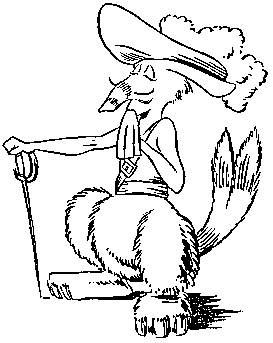Two Halls at the NEC
Pevans reports from the 2017 UK Games Expo
My report is written as a narrative to be read through and focuses on the new (to me) games I played. You can start with my introduction or use the indexes below to find something specific.
It is also available as a PDF document: UK Games Expo 2017 report (5 Mb). (You will need Adobe Reader to view this document – use the link to download it if necessary.)
- Exhibitor index
- Introduction
- The Retailer Summit – Esdevium's Thursday showcase
- Press Preview – an early look at some of the new games
- Trying some games (or, what I did on Friday)
- Walking the Halls – all the rest
Exhibitor index
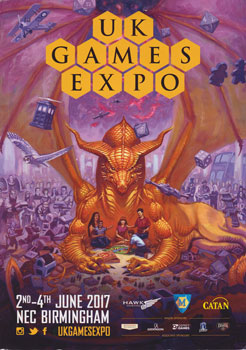 Introduction
Introduction
The Expo continues to grow, as does the programme booklet (that's the cover on the right), which is now over 100 glossy A4 pages). This year the event occupied two halls at the National Exhibition Centre (NEC) along with the function areas at the Hilton Metropole (a short walk away on the NEC site). The whole of Hall 1 was given over to the trade hall, stuffed full of publishers and distributors displaying their latest titles and retailers selling them - and a lot more. Hall 3a was the venue for many of the tournaments and competitions that take place during the Expo, with the Metropole hosting other events as well as the after-hours open gaming.
The Expo formally starts late morning on the Friday and finishes mid-afternoon on the Sunday: 2nd-4th June this year. However, my Expo started on the Thursday with my Games from Pevans hat on as I attended Esdevium Games's Retailer Summit. Esdevium is the largest games distributor in the UK and this is their showcase of publishers they handle. It's also an opportunity for the retailers who are selling at the show to see some of the new games - assuming they're not still busy setting up in the main hall.
At the Retailer Summit
First to report on, then, is what I saw at the Retailer Summit. I was very taken with the cartoon-style artwork of AEG's new edition of The Captain is Dead by Joe Price and JT Smith. The story here is that the players are the bridge crew of a Star Trek-style spaceship that's under attack by aliens. With the Captain dead, they must work together to re-boot the power core, maintain the shields and escape! Brilliant stuff with a real feeling of jeopardy as the players struggle with all the different problems. It gets an enthusiasm rating of 9/10 on my highly subjective scale.

Red alert: The Captain is Dead!
Custom Heroes, by John Clair, also comes from AEG and is a superhero-themed simple card game. The basic idea is getting rid of all the cards in your hand by laying sets of increasing size - anyone familiar with The Great Dalmuti or Career Poker will recognise this part. On top of this, the heroes depicted on the cards provide special abilities. And then the cards can be modified by adding features - as in Clair's earlier Mystic Vale. It's a clever idea, but I think I prefer my simple card games simple. It gets an enthusiasm rating of 5/10 on my highly subjective scale.
The final AEG title was Lovecraft Letter (see what they did there?), a Love Letter variant by Seiji Kanai himself. This adds insanity (what else?) to the brilliant, minimalist Love Letter while re-theming it to a Lovecraftian 1920s. Playing a card with an insanity symbol gives you access to alternative actions, at the risk of losing the round by going 'insane'. It's a neat, atmospheric variant on the original and gets an enthusiasm rating of 8/10 on my highly subjective scale.
Asmodee is Esdevium's parent company and was showing off some of the new products from the various publishers under its umbrella. Century: Spice Road comes from Plan B Games and I covered it in my report from this year's Gathering of Friends (see TWJO 174). From Space Cowboys comes a new edition of the classic no-luck deduction game, Sherlock Holmes Consulting Detective, which has been given their usual high quality production. I'm assured the rules have been tidied up from the original. This edition has several cases, starting with "The Thames Murders", and further cases are planned.
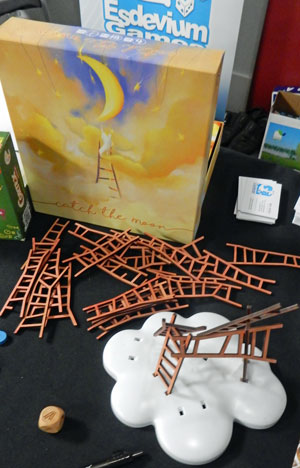
Balancing ladders in Catch the Moon
Catch the Moon comes from another French publisher in the Asmodee fold, Bombyx. It's a dexterity game where players use little ladders to build as high as they can. I was at a loss how to manage that, but the photos I've seen suggest that laying the ladders flat is the way to go. Hmm, I don't think this is my cup of tea.
I expected to see Palace of Mad King Ludwig on the Bézier Games table as I saw this development from Castles of Mad King Ludwig at the Gathering in April with designer Ted Alspach. Unlike Castles, where each player constructs their own castle from the different shapes and types of room tile, here players are working together on a single palace. However, it's still getting the right tiles in the right places that earn them points. The game ends when the moat around the palace is complete, but this depends on players' actions and can complete more quickly than they expect. Cracking stuff from Ted that I give an enthusiasm rating of 9/10 on my highly subjective scale. The finished game should be at Spiel.
Whistle Stop, designed by Scott Caputo, is another clever game from Bézier. This railway game marries track-building across America with pick-up-and-deliver. Players can either deliver the goods they pick up to gain additional resources as they lay hexagonal tiles to expand across the continent or hold on to them for a major pay-out when they reach the west coast. Another one I'll be keen to look at more closely at Spiel.
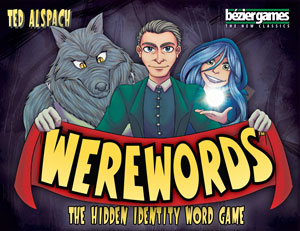 Werewords is another game from Ted Alspach himself and adds werewolves to what is essentially 20 Questions. As a team, players ask yes/no questions to identify a word randomly selected by a smartphone app. One of them, the Mayor, knows the word and tries to guide the players in the right direction. However, one is
secretly a werewolf and mis-directs them. The team wins if they find the word or spot the werewolf, unless the werewolf can then identify the Mayor. It's an interesting idea and I can see that it will be fun for the Mayor and werewolf. I'm just not sure what's in it for the other players - though I assume they get the chance to be Mayor or werewolf each round. It gets an enthusiasm rating of 5/10 on my highly subjective scale.
Werewords is another game from Ted Alspach himself and adds werewolves to what is essentially 20 Questions. As a team, players ask yes/no questions to identify a word randomly selected by a smartphone app. One of them, the Mayor, knows the word and tries to guide the players in the right direction. However, one is
secretly a werewolf and mis-directs them. The team wins if they find the word or spot the werewolf, unless the werewolf can then identify the Mayor. It's an interesting idea and I can see that it will be fun for the Mayor and werewolf. I'm just not sure what's in it for the other players - though I assume they get the chance to be Mayor or werewolf each round. It gets an enthusiasm rating of 5/10 on my highly subjective scale.
Blackrock Games is a French publisher/distributor and had games from smaller publishers in France. La Boîte de Jeu is a new name to me, but they've been around for a few years. Their new game, Outlive, is about surviving in a post-nuclear war world and was designed by Grégory Oliver. Each player has their own bunker (board) and a team of four to explore and scavenge the devastated city that makes up the main board. Supplies and materials allow players to feed their people and extend their bunker, giving them additional capabilities. The game is played over six rounds (days) each finished with an event - usually bad, often raising radioactivity levels.
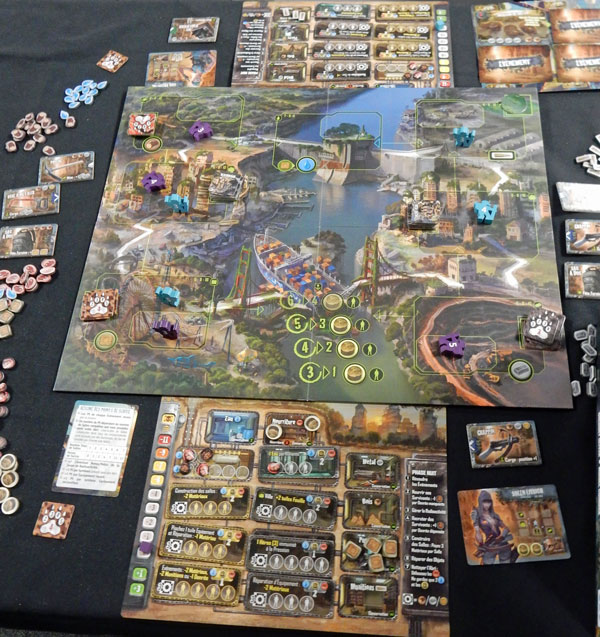
Outlive on display at the Expo
At the end of the game, players score points for the number of survivors they've kept alive, the size of their bunker and equipment rebuilt plus any events they've defeated and a penalty according to their radiation level. The events clearly add a random element to the game, but there are lots of options for the players in developing their position - and potentially protecting themselves from the events. Outlive is another game I'm looking forward to trying and it gets an enthusiasm rating of 8/10 on my highly subjective scale.
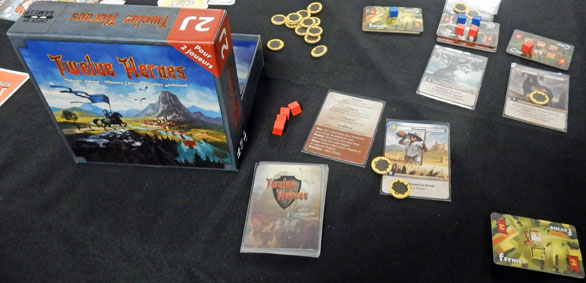
Catch Up’s Twelve Heroes
The other Blackrock title was Catch Up Games's edition of Twelve Heroes, a two-player game of military conflict designed by Takashi Sakaue and Masato Uesugi. It was summed up for me as Battleline meets Magic: the Gathering. The former suggests the format: players deploying their troop cards to fight over a number of different territories. The latter inspiration adds drafting or pre-built decks for setting up the players' initial armies. It looks interesting, but it's a two-player game and gets an enthusiasm rating of 6/10 on my highly subjective scale.
Czech Games Edition had their usual presence. Prominent was the latest in the Codenames family: Codenames: Duet. As the name suggests, this is a two-player game. Less obviously, it's a co-operative game. Players are still giving single-word clues to identify the word cards that represent their agents. However, in this version the two-sided card that shows which are the right agents gives each player different, partial information. The players work against the clock to locate their agents. Co-designer Vlaada Chvatil, along with Scot Eaton, is up to his usual clever tricks. However, two-player games are not my thing, so this gets an enthusiasm rating of 7/10 on my highly subjective scale.
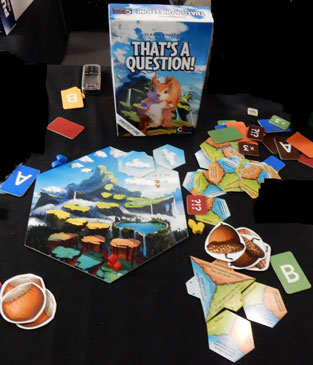
Not only squirrels, but nuts too
Next up at CGE was Pulsar 2849, designed by Vladimir Suchy. This is an interstellar exploration game with players' activities powered by the dice they draft. I got to play this later on, so I'll cover it in more detail later. Finally, we had That's A Question, a party game from Vlaada Chvatil. As you'd expect from this designer, there's rather more to it. In this case, one player has to choose an answer to a question. The others then bet on which answer they've chosen before it's revealed. They score for getting it right, while every wrong guess scores for the player questioned. It's a neat idea, reminding me of the old TSR game, I Think You Think I Think, but it gets an enthusiasm rating of 6/10 on my highly subjective scale. Oh, and what's with the squirrel motif? "Vlaada likes squirrels," I was told.
Greater Than Games were showing pre-production copies of two new games - both under their "Fabled Nexus" brand. The glittering pieces of Lazer Ryderz (designed by Anthony Amato and Nicole Kline) made me think disco, but the game is a race between players surfing laser beams in space. Each player has a selection of glitter-adorned strips that represent the different ways they can move their figure across the table. The strips also block other players, providing tactical options, and there's a push-your-luck element as well. The winner is the first player to reach the three 'prisms' scattered around the table. It's quite bonkers, but should be good fun and is certainly eye-catching. It gets an enthusiasm rating of 7/10 on my highly subjective scale.
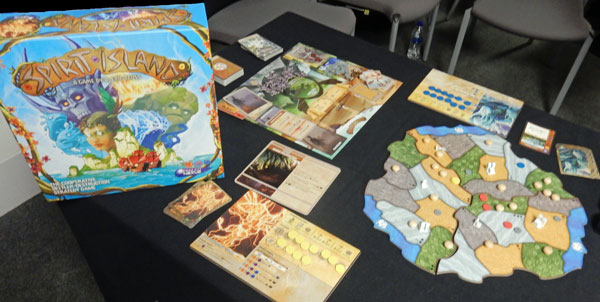
Spirit Island on display
GTG's second game was Spirit Island, which is a bit more subdued in its colour scheme. This is a co-operative game that has the players representing the several spirits of the land, defending their island from invaders. The invaders' actions are programmed, but variable, giving the players some idea of what they'll do, but not certainty. As they spread, they build settlements and spread blight, which the players try to destroy and cure. Designed by Eric Reuss, Spirit Island looks an intriguing game and I give it an enthusiasm rating of 7/10 on my highly subjective scale.
German publisher/distributor Pegasus Spiele had a couple of new games. The first, from eggertspiele, is Frogriders, designed by Asger Harding Granerud and Daniel Skjold Pedersen. This looks very silly: it's an array of model frogs being ridden by elves. No, really. By moving their Frogriders, players can capture opposing figures (jumping over them) and either keep them to score points or return them to use their special ability. There's clearly some tactics in this, but it is aimed at family play rather than gamers.
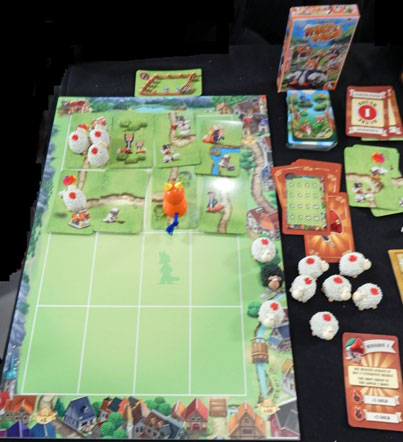
Sheep & Thief on display
The second game is Sheep and Thief by Yuichi Sakashita and originally published in Japan. Players each have their own board, onto which they lay tiles, Take It Easy!-style, to build up a network of fields containing sheep. The problem comes when the thief figure moves on to a field and makes off with Flossy. To avoid this, players try to herd their sheep into pens to keep them safe. It looks an engaging game, though another clearly intended for families.
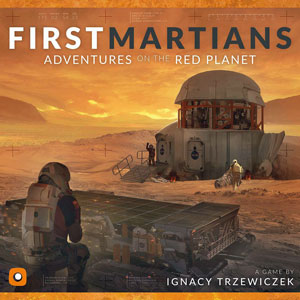 Portal Games is the publisher behind games like Robinson Crusoe and one of their offerings at the Expo was a development of that game, First Martians. Designer Ignacy Trzewiczek has transferred his excellent co-operative game from
a "Cursed Island" to the Red Planet and tweaked it along the way. The big difference, it was explained to me, is that in Robinson Crusoe players go looking for adventures, while in First Martians adventures will kill them!
Portal Games is the publisher behind games like Robinson Crusoe and one of their offerings at the Expo was a development of that game, First Martians. Designer Ignacy Trzewiczek has transferred his excellent co-operative game from
a "Cursed Island" to the Red Planet and tweaked it along the way. The big difference, it was explained to me, is that in Robinson Crusoe players go looking for adventures, while in First Martians adventures will kill them!
Players' first priority is maintaining the systems that keep them alive in this hostile environment. Each player has a cardboard 'console' with green cubes slotting in to show what's working - and red ones for what's not. On top of this, there's a central board with some great little models of the base, rovers and other equipment. Players will need to explore, hoping to find materials that will help them repair and upgrade their equipment. There is a smartphone app for this part of the game, though the game can be played fine without it.
I'm a fan of Robinson Crusoe and I can see that First Martians maintains the same edge-of-disaster tension. It also looks good. I give it an enthusiasm rating of 9/10 on my highly subjective scale and look forward to getting my hands on a copy. Portal also had Alien Artifacts, which I got to play later in the show (see below or follow the link).
PSI (Publisher Services Inc) is a US distributor handling small American publishers that reaches Europe through Esdevium. The first thing I spotted on their table was Near and Far from Red Raven Games. This is Ryan Laukat's sequel to his Above and Below, as is clear from the artwork and style of the box. Like the original game, story-telling is at the heart of the game, as players explore. This time, however, the game is about a journey, both in terms of what players' characters are doing and their own personal development.
Near and Far can be played as a single "story" or as a "campaign", which is closer to a role-playing game with players developing their character between adventures. While players each have a single character, they also recruit adventurers (and pets!) to make up a team. They then equip their team before setting off to explore the world - a set of maps in the game's "Atlas" - and fulfil quests. The things they do along the way will earn them "journey" points and these determine the winner.
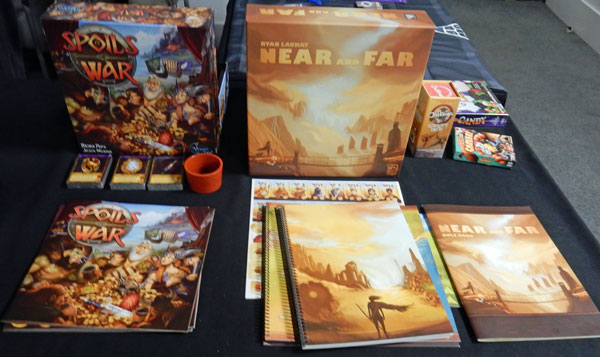
Near and Far and Spoils of War
All of this makes Near and Far feel close to one of my all-time favourite games, Tales of the Arabian Nights, with the addition of an over-arching story in the campaign version. On this basis, I give Near and Far an enthusiasm rating of 9/10 on my highly subjective scale.
PSI had titles from Steve Jackson Games as well, including last year's Ghosts love Candy, designed by Danny Devine. This really is a game of taking candy from children! It's an entertaining game of bright colours. Players use their team of ghosts to possess trick-or-treaters and eat the sweets they collect. Most sweets eaten wins the game when they're all gone. Very silly.
Arcane Wonders were also represented by PSI with Spoils of War, a game of bidding and bluffing designed by Jason Medina and Bryan Pope. This has the players as Viking warriors, squabbling over the heap of loot they've plundered. There's an element of Liar's Dice as players roll a number of dice and bid based on what all players have of a particular number. When this is challenged, players bet on whether the challenge will succeed or not. Those on the winning side gain treasures. After nine rounds, the game ends and players score their remaining gold and the value of their treasures with bonuses for sets of the same or different types of treasure. It looks a neat game with an entertaining theme: I'll start it at an enthusiasm rating of 7/10 on my highly subjective scale.
I taxed the representative of Belgian publisher Repos Production with not wearing a sombrero, whereupon he promptly pulled one out from below the table. I do like a bit of style! When I Dream is a deduction party game, designed by Chris Darsaklis. One player, the dreamer, wears a mask while the other players draw picture cards and describe them with a single word. The dreamer selects or refuses the word, which goes into either the naughty or nice pile - players are secretly in the naughty, nice or balanced team and score appropriately. After two minutes of this, the dreamer recounts the story of their dream, incorporating the words they selected. This adds a tough memory element to the game. I'm afraid this is another one that really doesn't appeal to me, so it gets an enthusiasm rating of 3/10 on my highly subjective scale.
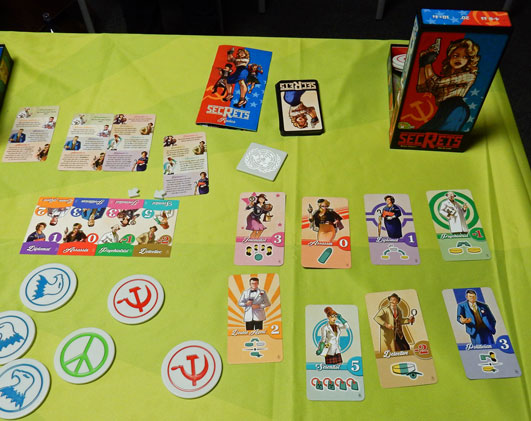
Showing off the style of Secrets
Secrets is more to my taste. Designed by Bruno Faidutti and Eric Lang, this takes us back to the Cold War and pits three secret teams against each other. Two of the teams are the expected CIA and KGB with the third being the Hippies. Thus, the CIA and KGB try to out-do each other - while identifying their team-mates - but the Hippies just want to score the least. This means the other two teams must ensure that Hippies do score.
Gameplay is simple as each player in turn draws two cards and offers one to another player. If they accept it, they add it to their scoring pile; otherwise it goes to the offering player. As well as points, the cards have abilities, making the interactions increasingly complex, particularly when players bluff about which abilities they have. The game reminds me a bit of Bruno Faidutti's Mascarade, which is one of the funniest games to play. Here, it's the addition of the Hippies that lifts the game out of the ordinary. I give it an enthusiasm rating of 7/10 on my highly subjective scale.
WizKids was represented by Zev Shlasinger (aka the Z-Man), who heads their board games operation now, and had several forthcoming titles to show us. The Banishing (designed by Sean Rumble) is a co-operative card game with a fantasy theme. Players put together sets of cards to meld in order to "complete the ritual of Banishing". Deadline is a co-operative deduction game from Dan Schnake and Adam West. The game has a hard-boiled film noir theme - a kind of Sam Spade Consulting Detective - with players managing their hand of cards to solve the crime.
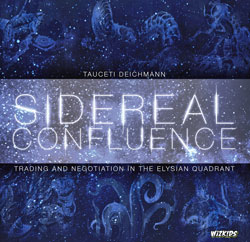 DiceBot MegaFun (designed by Jeremy Kalgreen, Lance Seman and Christopher Volpe) has players drafting dice whose symbols represent different components of their bot and then using the bot they've constructed and their weapon cards to take out the other players' creations. It looks to be colourful, silly fun. Fantasy Realms by Bruce Glassco is a card-drafting
game of constructing a fantasy realm by building the right card combinations. It plays quickly and offers plenty of different options.
DiceBot MegaFun (designed by Jeremy Kalgreen, Lance Seman and Christopher Volpe) has players drafting dice whose symbols represent different components of their bot and then using the bot they've constructed and their weapon cards to take out the other players' creations. It looks to be colourful, silly fun. Fantasy Realms by Bruce Glassco is a card-drafting
game of constructing a fantasy realm by building the right card combinations. It plays quickly and offers plenty of different options.
The most interesting (to me) of the WizKids selection was Sidereal Confluence from designer TauCeti Deichmann. It's a game of trading as players must bargain and negotiate for everything as they compete to develop their galactic civilisation. Of course, trading helps the other players as well as you, so the trick is to come out on top across all the deals. Zev described it as "Chinatown on steroids", which seems apt.
Tournament at Camelot (designed by Karen Boginski, Jody Boginski-Barbessin and Kenneth Shannon) is a trick-taking card game where the cards represent weapons used by knights in tourneys. The aim is to take the least damage throughout the tournament. Finally, there is Tower of London, an area majority game designed by (Daryl Andrews and Stephen Sauer). Players use their beefeaters to gain control of different areas of the Tower, while also collecting the all-important ravens. There's clearly plenty going on at WizKids.
The Press Preview
Before the Expo formally opens on Friday, the games library area is used to give the press a first look at the exhibitors. Having swapped into my TWJO hat, I went along to this - even though it was a 9 am start.
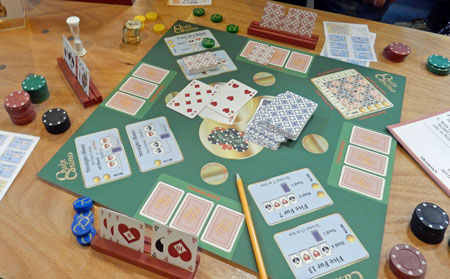
Quiz Casino on display
Self-published by Cards on the Table Games, Quiz Casino is an odd sort of portmanteau game. You start by playing a casino game to get the chance to answer a trivia question. You can see the subject of the question, so have some idea whether it's worth going for it. Answering the question correctly lets you add a card to your hand. You can then play a Poker hand to win coins and the player with the most coins wins the game. I have no idea whether this bizarre combination will appeal to anyone, but it certainly leaves me cold: that's an enthusiasm rating of 2/10 on my highly subjective scale. If you want to try it, the game is available to order from the website.
Flip the Script is a lightweight card game of Hollywood movie-making. Players draw cards to get three actors, a genre and a setting. They then have a couple of minutes to come up with a pitch for a movie that incorporates all five. Everybody delivers their pitch and players vote for the best. ("Rotten Roll: Samuel L Jackson and Emma Watson as mis-matched cops investigating the corrupt dealings of a pop music promoter played by Christopher Walken." How's that?) The game's Kickstarter project was cancelled on 14th June, but designer Mark Seymour plans to try again later in the year. It gets an enthusiasm rating of 6/10 on my subjective scale.
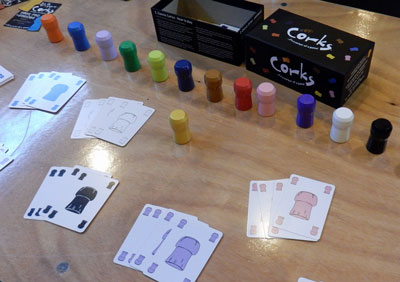
Lots of brightly coloured Corks!
Corks!, from Ginger Fox is an elimination game and appears to be a re-working of the venerable Spoons (as BGG has it - the version I know is Grab-a-nana). Players pass cards until someone has collected a set of four. They take one of the corks (or plastic bananas) from the centre of the table, whereupon everybody else can grab one. Except that there's one less cork than there are players and someone is eliminated. Remove a cork and play another round... Corks! has a tactical finale for the last two players. The game is, of course, complete mayhem - I can recall table and chairs going flying in the struggle for the last 'nana! It gets an enthusiasm rating of 3/10 on my subjective scale.
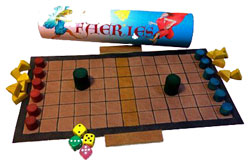 Faeries is a two-player abstract game from The Historic Games Shop under their Gothic Green Oak brand.
I know, this is clearly not my thing, but the theme is so bonkers I have to mention it. Each player has a team of Faeries (pawns) and an ogre (larger pawn) plus some cheese (yellow wedges). The aim is to get your Faeries to the safety of the central strip of the board while hurling cheese at your opponent's faeries to eliminate them! All this is done by rolling dice, so there's a big element of luck. However, there's room for a little tactics - and it's good fun. It gets an enthusiasm rating of 6/10 from me.
Faeries is a two-player abstract game from The Historic Games Shop under their Gothic Green Oak brand.
I know, this is clearly not my thing, but the theme is so bonkers I have to mention it. Each player has a team of Faeries (pawns) and an ogre (larger pawn) plus some cheese (yellow wedges). The aim is to get your Faeries to the safety of the central strip of the board while hurling cheese at your opponent's faeries to eliminate them! All this is done by rolling dice, so there's a big element of luck. However, there's room for a little tactics - and it's good fun. It gets an enthusiasm rating of 6/10 from me.
Faeries (courtesy of The Historic Games Shop)
Honeysuckle Games is an incongruous name for the publisher of Zombie Babies. I think the title says it all, really. Players are toddlers at a nursery, where the zombie apocalypse is just starting - with the other children! Players aim to improve their character's stats by finding items, completing quests and, of course, beating the zombies - some dice-rolling required. It's an amusing take on zombie games, so watch out for it on Kickstarter. My subjective enthusiasm rating is 5/10.
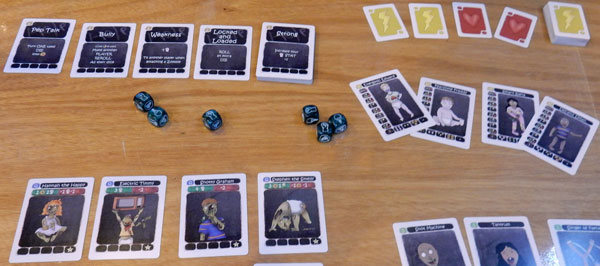
A selection of Zombie Babies
As well as being main man at the Expo, Richard Denning is a game designer, publishing through his imprint, Medusa Games. News here is that a new edition of their marvellous The Great Fire of London 1666 is on the way. Medusa's prototype at the Expo was Magnificent Flying Machines, a board game inspired by the air races of the early 20th century and co-designed by Richard with Matthew Comben. The game features a long board for the race, divided into areas through which players move their model planes. As if racing wasn't enough, players can stop to collect and deliver passengers and cargo along the way and carry out aerobatics. All of these score points and it's the most points that wins the game, not reaching the finish line first. Mind you, just reaching the finish line can be an achievement as players have to pass checks to land, take off and keep their plane flying. The status of their plane is shown on each player's 'dashboard' so that they can decide just how much of a risk to take. Plus there's the opportunity to impede the opposition with 'Dastardly' actions. I'm looking forward to trying this as it definitely looks like a fun game and give it an enthusiasm rating of 8/10 on my highly subjective scale.
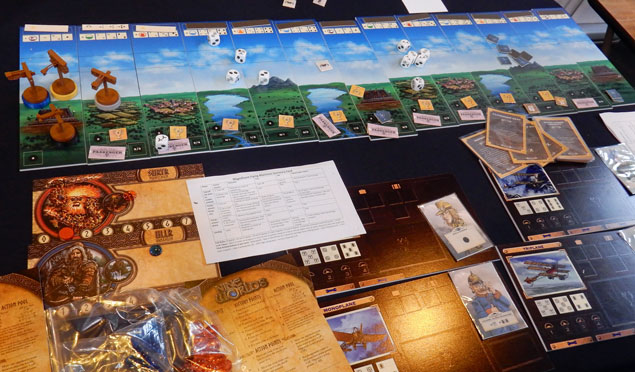
Magnificent Flying Machines prototype (plus some stray bits from Nine Worlds)
Scrooge: the Board Game looks a typical roll-the-dice-and-move-the-dobber mass market game. However, moving around the tracks on the board is only the start. These represent the streets of London, where players collect the cards that will help them outwit Scrooge and the other players. Card play provides plenty of tactical opportunities, particularly when it comes to thwarting your opponents. It looks an entertaining game and is scheduled to appear on Kickstarter early in September. It gets an enthusiasm rating of 4/10 on my highly subjective scale.
SoftWar is a two-player abstract strategy game played across a hexagonal grid with dice of different sizes. Players start with a number of dice on the board, representing their 'data crypts'. Players' other dice represent hackers trying to get into the crypts. The bigger the die, the faster it moves, but the less damage it does, so players have plenty of options in what they do. This is so not my thing - an enthusiasm rating of 2/10 on my highly subjective scale - but anyone interested should follow up on the website.
Escape the Dark Castle from Themeborne puts together an interesting mixture of elements. To start with, it's an escape-the-room game. It's also a co-operative, with the players working together to get out of the castle. Then it's a choose-your-own-adventure game: the players decide how to react to the situations on the cards as they come up. And the whole thing is enhanced by the moody, crude artwork. It was funded via Kickstarter in a project that ended on 30th June and raised five times its goal. It gets an enthusiasm rating of 6/10 on my highly subjective scale.
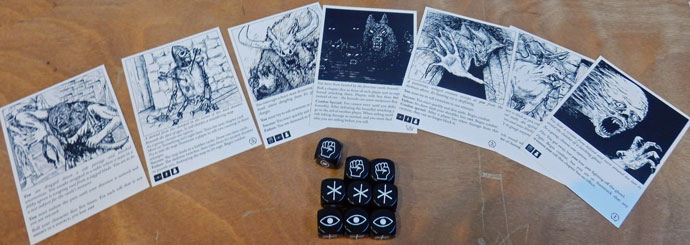
Escape the Dark Castle: cards and dice
Trying some games
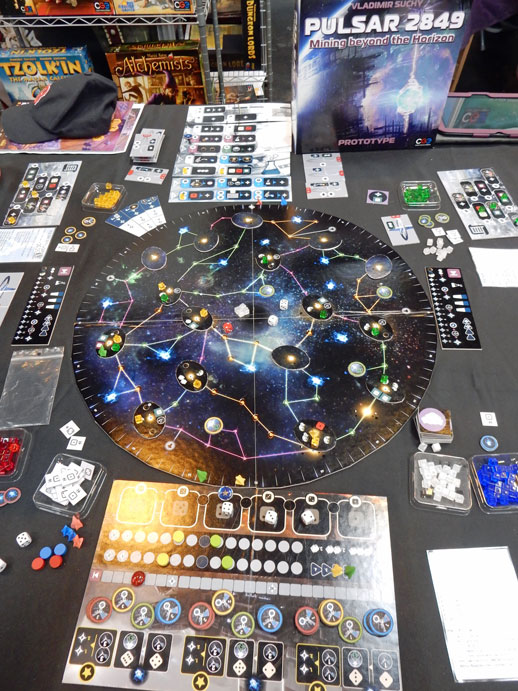
The Pulsar 2849 prototype at the CGE stand
Once the Expo was officially open, Pete Card joined me to try some of the games. Our first port of call was the Czech Games Edition stand to try the prototype of Pulsar 2849 (the game's working title) by Vladimir Suchy. At the beginning of each round, one player rolls dice (how many depends on the number of players) and arranges them in groups of the same value. Players then take it in turns to use one die to power an action. High value dice are usually more useful, but taking a die above the median value disadvantages that player on either the turn order or power cubes track. Conversely, taking a die below the median improves their position on one track.
Players' actions include developing their own 'technology tree' - on their personal board - to gain bonuses. They can also move on the main board (exploring systems or claiming pulsars), acquire alien technologies and build 'megastructures' (which are worth points). The pulsars are important as players can build and upgrade facilities on those they've claimed to score points and gain production.
The game lasts a set number of rounds with final scoring for achieving various goals. There are a lot of these and players can aim for them from the start. However, it's clearly not possible to complete them all, so they have to make strategic decisions. This is on top of the tactical decisions each round. Pulsar 2849 is a clever game that gives players a lot to think about - and lots of options on what to do. However, we felt the two-player game needed a bit more work. I look forward to seeing the completed game at Spiel in October and, in the meantime, give it a provisional 7/10 on my highly subjective scale.
Sticking with the science fiction theme, we spotted Stellar Transporter from Rowenson Games. This is a pick-up-and-deliver game in outer space. Players move their spaceships between star systems, which costs money: 10 'credits' per leg with a premium for passing through space stations owned by other players, according to the type of cargo carried. Contract cards, drawn at random, give players the origin and destination of their trip (they can go in either direction). When they arrive at the pick-up point, cargo is drawn at random, too.
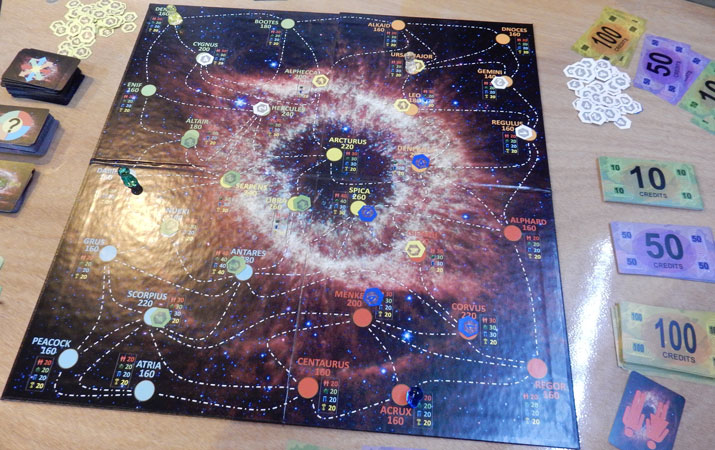
Stellar Transporter in play
On top of this, players may have to draw chance cards, which inflict random events on some or all players. As well as making deliveries, players can buy space stations at the star systems they land on. They can then upgrade these with houses and hotels, increasing the cost for other players who end there. The game is played until all but one player has gone bankrupt and the last person left is the winner. Oh dear. That was going so well until it sank under the weight of the Monopoly mechanisms.
There may still be a decent game here: take out (most of) the random elements (players take a displayed contract when they arrive at one of the systems shown, to a maximum of 1 or 2) and find a sensible game-end condition (play for x rounds? First player to complete y contracts?). Assuming the costs still make sense, I'd play that game. However, I suspect I'm not the target audience for the game as it is. It gets an enthusiasm rating of 3/10 on my highly subjective scale.
Pete's wargaming interests took us to look at El Alamein, a deck-building wargame of WW2 in North Africa designed by Atsuo Yoshizawa. This was being shown by Kamikaze Games, who produce the US version - the original comes from Arclight Games in Japan. The game is available in two versions: one illustrated with contemporary photographs; the other using animé-style suggestive drawings of scantily-clad buxom girls! This is just so bizarre.
Anyway, we tried the historical version, playing a few rounds to get the hang of it. Intriguingly, all players are Generals in the Axis forces, trying to out-do each other in their results against the Allies. Players deploy cards from their hand, paying their cost (if any) in 'Tactic' points - some cards provide Tactic points. These cards remain in front of players as their forces in play. Having played as many cards as they want, players may then buy cards, using 'Reinforcement' points which some cards provide. These go on to the player's discard pile and only become available when they cycle into their hand. At the end of their turn, players discard unused cards and draw fresh cards from their deck, shuffling their discards if necessary.
Once per turn, a player can declare a battle, attacking the top card on the 'Target' deck. If they can at least match the defensive value of the target with their troops, they win the card. Some of the cards are North African cities, which usually have extra troops defending them. What's more, attacking a city will provoke a British counter-attack. However, it is taking cities that will do the most towards winning the game - and the game ends once Alexandria has been taken. The winner will be the player who's contributed most (i.e. has the most victory points).

Building up my army for El Alamein
It quickly became clear that there is a real game here, making good use of the deck-building mechanisms. Having all players on the same side is an interesting twist and means the game is not restricted to two, opposed players. The different sets of cards available provide lots of ways of building up your forces and experience will teach how best to use each type of card. I give this a provisional 8/10 on my highly subjective scale and will be looking to pick up a copy when I can. There's also an earlier game, Barbarossa, which applies these game mechanisms to the Eastern Front.
Our next port of call was Portal Games to try the prototype of Alien Artifacts, designed by Marcin Ropka. This is a fast-playing card game where the players are exploring and expanding across the galaxy. The reason it moves quickly is that players can only do one thing each turn: draw cards, store cards (for later use) or use one. Cards generally show two different types of resource, providing plenty of flexibility in how they're used.
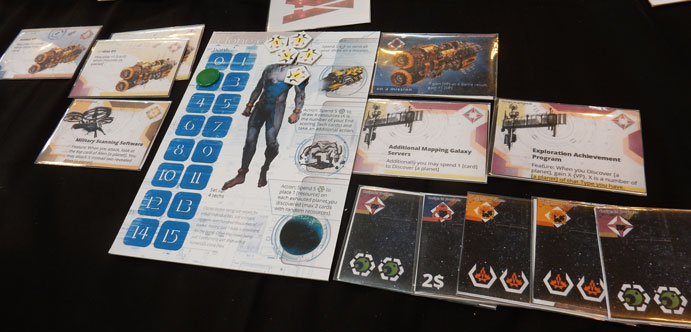
Spaceships to the left of me, spaceships to the right... My position in Alien Artifacts – note all those discounts at the bottom right
Essentially, players use their cards to gain spaceships, technologies and planets. One clever touch is that each of these can be used either for its ongoing effect (discounts, bonuses) or as a one off (for extra cards, end-game points). As players build more, their abilities, and the strength of these, increase. This makes it easier for players to do things, but can delay play as they work out just what discounts they can apply.
I thoroughly enjoyed Alien Artifacts, though I did feel it went on a bit too long. This is despite individual turns playing very quickly once we'd grasped the game's mechanics. I look forward to seeing the finished article at Spiel and give it a provisional 7/10 on my highly subjective scale in the meantime.
Walking the Halls
I was on my own for Saturday and Sunday as Pete was involved in a wargame tournament across both days. (The Memoir '44 tournament, which I usually play on Saturday, didn't take place this year.) This gave me plenty of time to walk the show, checking every aisle in an effort to see everything. Here's what I found - though it's by no means an exhaustive list - in alphabetical order of publisher.
I didn't recognise the name Alley Cat Games until I spotted that they are the publishers of Lab Wars, which I liked at last year's Expo. The same designers are behind Cauldron Master, which was also on the Alley Cat stand. This is a card drafting and set collecting game of witches putting together the ingredients for spells (eye of newt, anyone?) This year's prototype was Dice Hospital, which uses dice as patients, their overall level of health given by the number on top. This will be launched on Kickstarter in September.
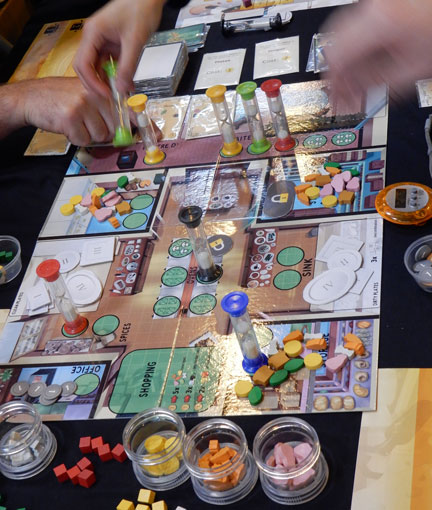
Frantic stuff: the Kitchen Rush prototype in play
Artipia Games was showing the highly enjoyable Fields of Green. Their preview game looked absolutely bonkers. Kitchen Rush is a real-time co-operative game of a restaurant kitchen. I can feel the time pressure already. Players take on tasks to acquire ingredients, prepare dishes, serve them and take money, each with a 20 second timer. Each player has two timers and can thus be doing two tasks at the same time. However, they can't move the timers to new tasks until they've run out. Cue mayhem! I can see this being a riot and it plays really quickly - each round is just a few minutes of furious activity. Kitchen Rush gets an enthusiasm rating of 9/10 on my highly subjective scale.
Cloud Island is familiar to me from their terrific game about the 1956 Hungarian Uprising: Days of Ire. The new game they had on show was Petrichor, a game of competitive raining. Yes, the players are clouds, raining on crops. They are also absorbing other, smaller clouds to increase their rainfall and deciding just where the rain should go. The aim is to have watered the most fields (or the most valuable fields, perhaps), so it isn't necessarily the player who finishes the game who wins. The game is fetchingly illustrated and players have little cardboard trays to move their raindrops around. It's so daft I just have to give it a go. It was successfully funded on Kickstarter in May and is expected to be available at the end of the year. Petrichor gets an enthusiasm rating of 8/10 on my highly subjective scale.
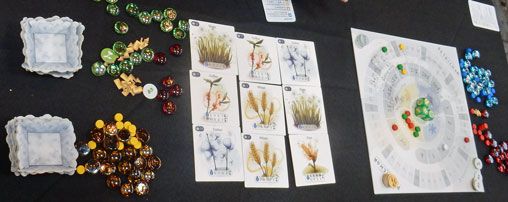
Petrichor being demonstrated
One of the unexpected highlights of the Expo for me was meeting Rory O'Connor, the man behind Rory's Story Cubes. If you haven't come across these before, get a set immediately. Apart from using them as a game, these dice with strange icons are a wonderful tool for inspiring your imagination. Anyway, Rory's outfit, The Creativity Hub, was at the Expo to introduce us to Untold. This is a co-operative game where players use cards and, of course, Rory's Story Cubes to create their own story. It sounds like a brilliant way to harness what the story cubes can do and I look forward to its arrival in the Autumn.
Gangly Games are the tall, skinny blokes behind Gangs of Britannia: a game of mob warfare across the cities of Britain - think Peaky Blinders meets the Krays. Players try to manoeuvre their gang into a dominant position by out-guessing their opponents - or working together for mutual advantage. There's a clever 'Prisoner's Dilemma' mechanism at the heart of the game. I'm intrigued to see how the finished product works. For the time being, it gets a 6/10 enthusiasm rating on my highly subjective scale.
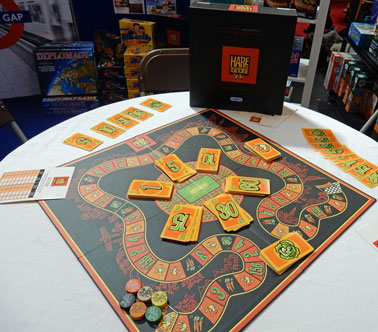
Hare and Tortoise on the Gibsons stand
A highlight of the Expo for me was the presence of Gibsons, the venerable UK games publisher. Their focus in recent years has been more on jigsaw puzzles than games, so it was great to see them at the show with some games. These included deduction game 221B Baker Street, David Parlett's classic race game Hare and Tortoise and the clever Sherlock Holmes: the Card Game.
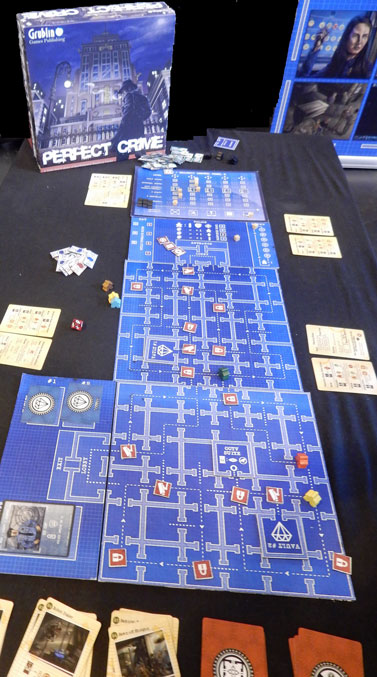
Perfect Crime laid out for play
Grublin Games's latest is Perfect Crime: a one versus many heist game. One player is the bank's security chief, hidden behind a privacy screen, while the team are the bank robbers. The robbers' first task is to plan their heist. The longer they take doing this, though, the longer the other player has to beef up the bank's security, hire staff, and stuff the vault with goodies.
When they're ready (or run out of time!), the robbers make their play and the game gets more detailed as the heist is played through, action by action. At the end of the game, the winners will be the side that has the most money, whether this is what the robbers have got away with or what the bank has preserved in its vault.
This looks great fun and I particularly like the blueprint look of the game's boards. It's expected to be available from September and I await the chance to give it a go. For the time being it gets an enthusiasm rating of 7/10 on my highly subjective scale.
ITB (Inside the Box) Board Games had their latest games on their stand: Sub Terra, a horror-themed co-operative game of surviving in underground caves, and Statecraft, a card-based game of political machinations. They were also demonstrating their next game, Newspeak. This is for two teams within a dystopian future: the dissidents are trying to expose the truth, while their opponents attempt to thwart them. The dissidents openly try to establish a meeting place on the board (which shows Mysterium-style illustrations, full of intriguing detail), by using code words. Their opponents try to guess where the meetings are and, eventually, to crack the code. It's an intriguing idea, but I could feel my brain melting as I played it. It gets an enthusiasm rating of 3/10 on my highly subjective scale.
Mayfair/Lookout had a substantial presence at the Expo, but the only new game I noticed was Bärenpark, designed by Phil "Imhotep" Walker-Harding. This is a family game, challenging players to fill their board with polyomino-style tiles, each adding features (and different bears) to their zoo/park. I can see this being seriously competitive with gamers playing, while being a fun challenge for family play.
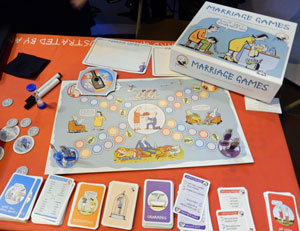
The Marriage Games set
I was drawn to Polish publisher MDR Dystrybucja by the entertaining cartoons displayed on their stand - these are amusing even though they're based on stereotypes of male-female relationships. Marriage Games ("Gierki Malzenskie") is for up to four couples working together at "Mr & Mrs"-style parlour games ("what's your partner's favourite whatever?") to win the most cupids. Alternatively, a couple can play against each other for forfeits (such as three hours of the other's time for chores or whatever...). The main selling point seems to be the cartoons - MDR has several other titles featuring work from the same cartoonist.
Romanian publisher NSKN Games were previewing Shadowscape, their new quick-playing, dungeon crawl game. Played over a 5 x 5 grid of rooms that make up the dungeon, players use their heroes to defeat monsters and grab treasure. I was taken by the neat touch that limits what the heroes can do. Their possible actions are printed on double-sided cards and only the action on the face-up side can be used. Once used it's flipped over to reveal the other side. Hence you need to work out not just what actions you want to do now, but what you want to do next. Apart from this, it didn't grab me, so that's an enthusiasm rating of 4/10 on my highly subjective scale.
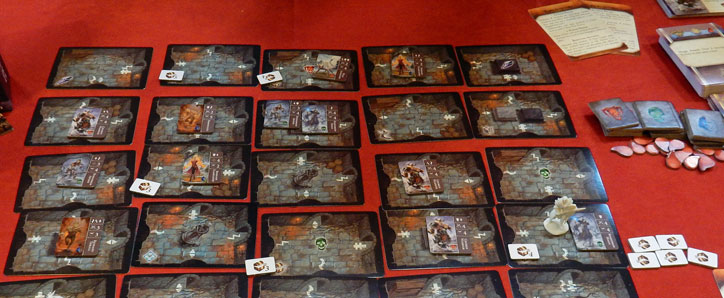
Shadowscape set up for play
NSKN have a "daughter" company in the form of Strawberry Studio, which produces smaller games, aimed more at family play. Their latest is Pyramid of the Sun (designed by Fréderic Moyersoen), neat little lightweight card game of constructing an Aztec pyramid. The small cards show part of a layer of the pyramid and will be laid in rows, each row offset from the one below (like bricks in a wall). Thus, the rows get smaller until the top of the pyramid is reached and somebody wins. There are actually two types of card: the cards in the smaller deck are edges and summits and can only be played in the right position.
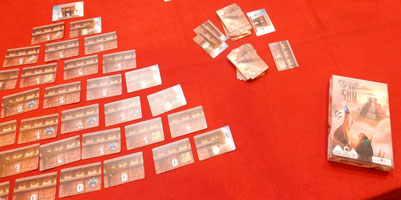
Pyramid of the Sun set out on display
In your turn, you can either draw two cards - from either or both decks - up to the hand limit or play as many cards as you want to. Cards must be played legally and score points as they're played: the number of points shown on the card plus the value of the layer it's in (the game starts with a 'level 0' base that defines how big a pyramid you're building). Edge cards score double and a summit triple - but ordinary cards can also be played on edges and at the top.
There's one other feature: some cards have icons on them as well as a value. When one of these is placed adjacent to other cards showing the same icon, the player takes extra cards or scores extra points. Pyramid of the Sun may be very light, but it's a clever little game that plays in the 20 minutes it's supposed to and provides at least that much entertainment. I was taken enough with it that I played it several times at the Expo and I give it provisional 8/10 on my highly subjective scale.
There has to be a story behind a publisher called One Free Elephant. However, it doesn't seem to be in the room at the moment, so let me mention the two games I spotted at the Expo. The first is Carcosa, in which players lead their cultists to build and, hopefully, control sections of the eponymous city. This is clearly one for gamers and Lovecraft fans and it was duly funded on Kickstarter in short order. Expect the finished article in October. The second game is completely different: Ore-some! is a family romp of digging ore out of a mine in the Wild West. However, this being the Wild West, what you dig out may not stay in your possession very long! It looks good fun and should be available now, having been funded in March.
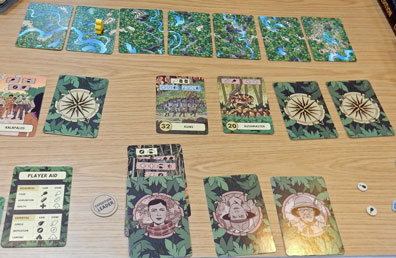
A demonstration of The Lost Expedition
It was good to see the current edition of Escape from Colditz on the Osprey Games stand - though it didn't look too different from previous version. However, the new game was The Lost Expedition, designed by Peer Sylvester. This is a co-operative game based on the last expedition of 1930s explorer Peter Fawcett in search of El Dorado. It is played with large cards that are very nicely illustrated. These represent the hazards - and assistance - the expedition encounters along the way. The aim is, of course, to reach El Dorado. A two-player version turns the game into a competitive race on top of the hazards. This is another interesting looking game and I look forward to trying it: an enthusiasm rating of 7/10 on my highly subjective scale.
German publisher Queen Games was prominent again at this year's Expo. Their latest Dirk Henn game is High Tide. This is a push-your-luck game as players try to get their deckchairs onto the beach as close to the sea as possible - but without being washed away! It's an entertaining game aimed at family play.
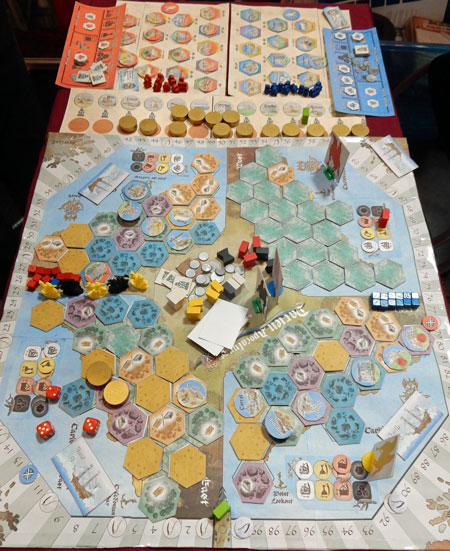
The prototype of Darien Apocalypse with lots of bits
As well as having their new edition of Backpacks & Blisters on sale, the Ragnar Brothers had a demo copy of their next "quantum" game, Darien Apocalypse, on their stand. Like the first game, Niña & Pinta, the theme is the exploration of the New World, in this case specifically the failed Scottish colony sent to Darien. In this game, there are four versions of the Panama isthmus for players to colonise, but they also have to combat the four Horsemen of the Apocalypse. As an alternative to pitting the players against each other, the game will include alternatives for co-operative and solitaire play. This was one game I fully intended to have a go at, but somehow I ran out of time. The Ragnars are still at work developing the game, after which it will be launched on Kickstarter. It gets a definite 9/10 in my highly subjective enthusiasm ratings.
Sinister Fish successfully launched their first game, Great Scott!, via Kickstarter last year and had the finished article on show at the Expo. Sub-titled "The Game of Mad Invention", this is a card game set around the Victorian Great Exhibition. Players draft cards to compile into a crazy invention - preferably with an alliterative title. There's then a story-telling element to get extra points as each inventor explains why their device is so much better than anyone else's.
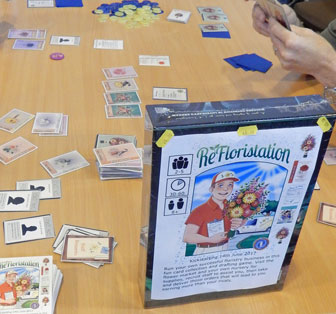
ReFloristation being demonstrated
Spiral Galaxy Games is mainly a distributor, but do have a hand in publishing. Their latest has the bizarre title of ReFloristation. This is a light card game (drafting and deck management) with a floristry theme. That is, players are running their own florist's shop: buying flowers, recruiting staff and meeting orders. The cards are nicely illustrated with, of course, different flowers. The game's Kickstarter project didn't raise the necessary funding, so Spiral Galaxy are exploring their options.
The surprise at Surprised Stare Games was that their new game was not from either Alan Paull or Tony Boydell. Instead we have The Cousins' War, a two-player of the Wars of the Roses, designed by David Mortimer. This is an interesting little game, played over a small board showing England (and Wales) divided into three areas. Controlling all three areas with your armies (wooden cubes) is an outright win, otherwise it's whoever's in the better position after five rounds.
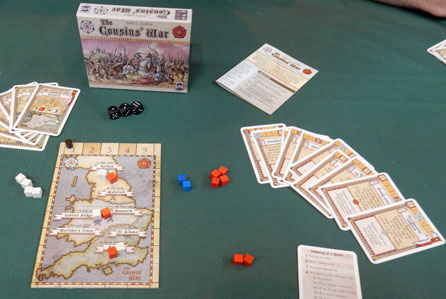
The Cousins’ War on display
It's actually a card game, with players using their cards to win a battle each round. Having established which battle is being fought, they play cards to add cubes to their side or remove them from their adversary. The battle is then fought in rounds, with each player trying to get the better result on three dice. The neat mechanism is that the first player rolls the dice secretly and claims whatever they feel like. The other player than has to decide whether to believe them, and try to beat their call, or challenge in the hope they're bluffing.
This is an entertaining mechanism that really makes the game. It plays quickly, too - 30 minutes is the expected duration. This is an attractive package that I'm keen to play - despite my traditional aversion to two-player games. I give it a provisional 8/10 on my highly subjective scale.
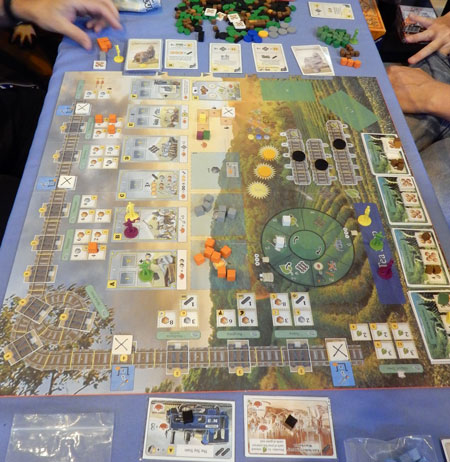
The prototype of A Nice Cup of Tea being demoed
Tony Boydell did have a prototype in action. This is a game about the establishment of tea plantations in Darjeeling, something that requires the construction of the Darjeeling Himalayan railway into the mountains. Yes, it's a development of Tony's terrific Snowdonia and has the working title of A Nice Cup of Tea. If I got the right end of the stick, there's a lot more going on around the construction of the railway line and the game is substantially different from Snowdonia. I look forward to seeing the finished article next year.
US publisher Tasty Minstrel Games was making their first visit to the Expo (and will be at Spiel in October). I was pleased to see their new edition of Corné van Moorsel's Samara (see my review of the original edition in TWJO 168). One change has been splitting the month boards into three sections, instead of two. Next up from TMG is a new, US edition of The Flow of History (see TWJO 169 for my thoughts on the original edition), which gets my seal of approval, too.
And then there's Crusaders: Thy Will be Done, a new strategy game designed by Seth "Eminent Domain" Jaffee. Interestingly, this is publicly described as combining roundel and Mancala mechanisms, but was explained to me as trick-taking area control. Either way, it's about orders of Christian Knights (think Templars) crusading in Europe and the Middle East. It's currently on Kickstarter, but has already raised over four times the required funding. I was intrigued to see it described as being in TMG's "Deluxified Format". My first reading of this phrase was that anything luxurious had been removed, but apparently it is intended to mean "de luxe". Expect the final item next year. This gets an enthusiasm rating of 7/10 on my highly subjective scale.
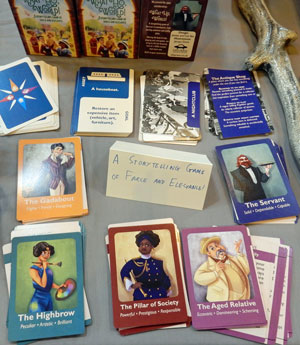
The What Ho, World! cards on display
UFO Press is better known for its post-apocalyptic RPG, Legacy, but main man James Iles also had a couple of card games to show me. What Ho, World! and Wizards Aren't Gentlemen are story-telling games, intended as an introduction to the wonderful world of role-playing games. As the title suggests, What Ho, World! is set in an imagined 1920s London, with Bertie Wooster and Jeeves just around the corner. (Wizards Aren't Gentlemen is a fantasy setting.)
About half the chunky deck is made up of the cards that define each character - though stereotype might be a better description. Thus we have the Gadabout, the Servant and the Aged Relative, to name but three. (Each has a picture card, double-sided so that characters can be male or female.) The rest of the deck is mostly Goal/Asset cards, which give characters something to achieve ("Prevent an international incident from spiralling out of control.") and an unrelated (or is it?) asset ("An enormous portrait of Queen Victoria.").
The final cards are locations, which give the characters somewhere to meet. Then it's over to the players. The game is played in scenes, players taking it in turns to be the focus. Their aim is to advance their goals through interaction with the other characters (and cunning use of their assets) with the players acting collectively to make refereeing decisions where needed. It's a neat idea and I'm taken with the Jeeves and Wooster setting. I give What Ho, World! an enthusiasm rating of 7/10 on my highly subjective scale.
Having given us Jane Austen's Matchmaker in 2014 and Game of Blame in 2016, warm acre had new projects for both under way. Jane Austen's Matchmaker: Chapter Two builds on the original game while adding more tactical complexity. While the core of the game remains making advantageous matches for your ladies and gentlemen, there is a third set of cards, influence, that gives players additional ways of gaining prestige. It was successfully funded on Kickstarter in May and should be with us before Christmas.
Blame Space will be "Game of Blame in space", apparently. It's time to abandon (space) ship and there's only escape pod! Players compete to persuade the mad computer to let them into the pod. Presumably by blaming the others. I look forward to finding out more.
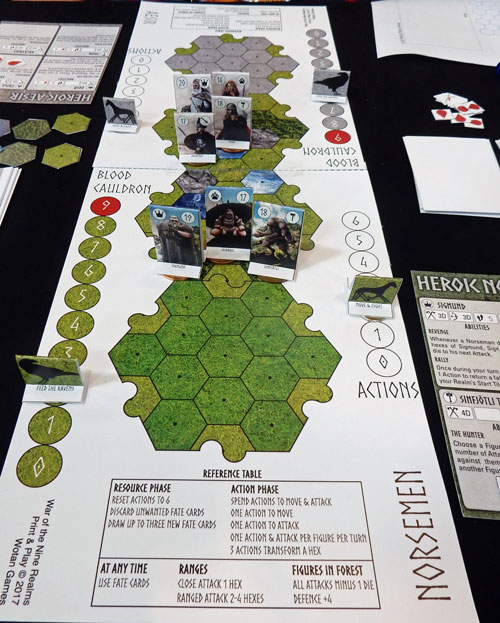
Playing War of the 9 Realms: my remaining heroes form
a defensive line, but the odds don’t look good
Wotan had their double-decker bus parked in the middle of the hall again. It is unmissable. They were showing off prototypes of their new game, War of the 9 Realms. As the name suggests, this is a Norse-themed wargame (well, skirmish game). Battles are fought over a hexagonal grid on large, hexagonal tiles that provide lots of different configurations. I tried the two-player game, which uses a narrow strip of tiles to force a direct confrontation between the players.
Each player represents a different race from Norse mythology, with their fighting pieces being significant figures - the Gods in the case of Asgard. In their turn, players have a limited number of actions to move and attack with their fighters. Some of these have bows, allowing them to attack from a distance. Do enough damage to an opposing character and it's removed from the board (certain characters are, essentially, cannon fodder and can be brought back on again).
Key to the game is getting your pieces into the right positions and making the best use of their strengths. The result is that the game feels surprisingly like an abstract strategy game - something I think will change when it's played with multiple players. As a new player, I was duly thrashed, but I definitely got an insight into the game. I can't say this is my kind of game these days, but I give it an enthusiasm rating of 6/10 on my highly subjective scale.
And that concludes my thoughts on the 2017 UK Games Expo. It's getting big enough that I need the whole time to get round everything, and I know there were people I missed. Warm congratulations to Richard Denning and the team for another excellent event and their success in growing it year on year. I expect even better things next year: the 2018 UK Games Expo is scheduled for 1st - 3rd June at the NEC. The Expo's website is the way to keep up to date
A shorter version of this report was published in To Win Just Once issues 175 and 176 (June-August 2017).

